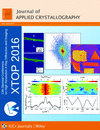issue contents
High-resolution X-ray diffraction and imaging special issue (June 2017)
Guest Editors: Virginie Chamard and Václav Holý
The articles in this virtual special issue of Journal of Applied Crystallography represent some highlights of the 13th Biennial Conference on High-Resolution X-ray Diffraction and Imaging (XTOP 2016). The topics of the published articles cover the broad spectrum of problems discussed during the conference, highlighting in particular four specific X-ray techniques: X-ray Bragg diffraction, small-angle scattering and reflectivity, X-ray diffraction imaging, and coherent (phase-sensitive) X-ray imaging. These open-access articles were originally published in the journal between April and June 2017.

Cover illustration: Some highlights from XTOP 2016. Images courtesy of Schmidbauer et al. [J. Appl. Cryst. (2017), 50, 519–524], Hagemann & Salditt [J. Appl. Cryst. (2017), 50, 531–538], Jiang et al. [J. Appl. Cryst. (2017), 50, 712–721] and Davtyan et al. [J. Appl. Cryst. (2017), 50, 673–680].
 access
access access
access access
access access
access access
access access
access access
access access
access access
access access
access access
access access
access access
access access
access access
access access
access access
access

 journal menu
journal menu



































